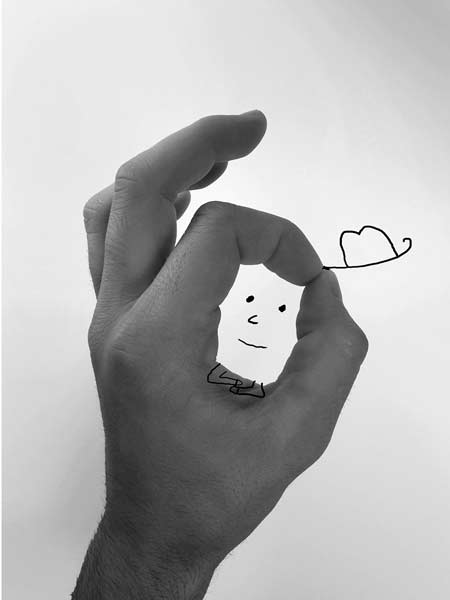Serge Bloch: The cartoon philosopher
 0 Comment(s)
0 Comment(s) Print
Print E-mail
Global Times, June 15, 2011
E-mail
Global Times, June 15, 2011
 |
|
‘Hand’ work by Bloch. Photo: Guo Yingguang/GT |
French illustrator Serge Bloch signed each of his books with an improvised doodle of one of his signature playful characters – a unique gift for his Chinese fans after his book tour across four cities earlier this month.
His award-winning picture book Moi J'attends, with its English translation as I Can't Wait, based on a story by Davide Cali, was introduced to China by Jieli Publishing House in 2009.
Profound pictorials
The serious-looking Bloch is bestowed with a childlike innocence, often repeating how he was lucky to be with his Chinese readers, young and old, and to travel the world meeting different people.
"I've been drawing for 30 years, a little more actually. I do it almost every day and enjoy it just as much, maybe more and more with time," he says on his website. "I opened my little inkwell, I dip by my little quill, my piece of bamboo, and I picked up my pencil. Every day the same ritual, the same movement, without getting bored, and I tell myself, 'You are so lucky…'"
His next illustrated book, Compter La Vie, based on scripts by Japanese screenwriter Kundo Koyama, will be published soon in China. But like the symbolic (but real) red embroidery used in I Can't Wait, it is fate that brought him to the Middle Kingdom.
The virtuoso book brings minimal lines to life with profound meanings. In 150 words and 25 two-page illustrations, a life's journey is weaved via a red thread that appears throughout the book, on top of the line illustrations.
This thread can represent the emotional bond between husband and wife, color on a bleak day, a bow in one's hair, a good-bye. It pushes and pulls, it gets tangled and tautened, it embraces and secures, it gets yanked, rent, and let go.
"I couldn't help but cry," said one female reader, displaying her favorite page in which a child lays in bed, waiting for a goodnight kiss.
 |
|
Illustration from I Can’t Wait.Photo: Guo Yingguang/GT |
Limited acceptance
Wang Lin, a researcher in children's books and promoter for children's reading, was present at Bloch's tour. A big fan, he said, "Though [Bloch's] a prominent artist in France, you hardly see him showing off his skills but instead presenting minimal imagery and brushwork with deep reflection. He doesn't please readers, nor conceal his real feelings."
The book has a wider readership in Taiwan, according to Wang, topping book sales list in Eslite Bookstore in 2007, while on the Chinese mainland, sale are middling. This is, the publishers say, because of the limited level of "acceptance" among readers for Bloch's style.
Wang said that such "philosophical" books needn't actually be difficult for kids. "Readers in different age groups have different understanding about this book," he told the Global Times. "It's a perfect book for parent-child reading."
Cai Lin, editor of the Chinese edition, said it was a risk publishing the book in 2009, since, although it was well received in developed cities like Beijing, Shanghai and Guangzhou, the book couldn't possibly gain much recognition in underdeveloped areas.
Unlike the many Chinese parents who forbids their children from reading what they consider "comics," Han Lihong, who took her 11-year-old daughter to the event in Beijing's Capital Library, was rather more open-minded toward Western values in education than her provincial peers.
"I won't choose for my daughter or push her to do whatever she dislikes," she reasoned. "At least now she has a good personality and won't be one of those suicide jumpers in colleges."
 |
|
French illustrator Serge Bloch. Photo: Guo Yingguang/GT |
Building a career
Born in 1956, Bloch had a series of blue-collar jobs, such as construction worker, and traveled extensively before attending the Decorative Arts School of Strasbourg in 1978.
He worked for the children's imprint Bayard Publishing for 24 years, and became the chief visual editor of the newspaper Astrapi, where he adopted his simplistic style for efficiency, easy comprehension and resonance. Later he created the young French comic book superhero Samsam, which French television is now turning into an animated series.
He is also a contributing illustrator to several US publications, including the New York Times, Wall Street Journal, GQ, Time magazine, and the Los Angeles Times.
He said he didn't find his own style overnight and his inspiration comes from everyday life. "It's like building a house, accumulating interesting stuff into a building. It's also like riding a bicycle, once you get started, the wheels will get rolling.
"My job is to delight my readers. If they smile after reading it, then I'm satisfied," concluded Bloch.






Go to Forum >>0 Comment(s)